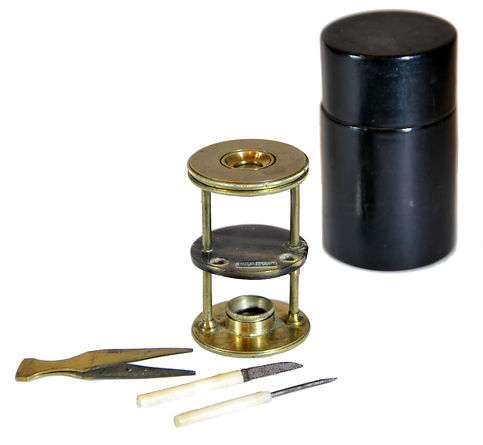

Withering-type botanical microscope, 1780
The “Withering-type Microscope” is named for its inventor, Dr. William Withering (1741-1799), an English physician and botanist who graduated with a degree in medicine 1766 in Edinburgh. Inspired by the taxonomical work and systematic classification of Carl Linnæus (1707-1778), Withering (1776) applied the Linnaean taxonomical system of classification to British plants in a seminal, two volume work, A Botanical arrangement of all the vegetables naturally growing in the British Isles. The earliest reference to a small botanical microscope of Withering’s design appeared in the first edition of this book. There, Withering indicated this microscope was developed for field dissections of flowers and other plant parts. While there is no surviving example of this exact design, close relatives of this type do exist, made either completely of brass or of ivory with brass pillars. Ivory models can be tentatively dated to 1776-1785, as by 1787 a newer model with a hollowed stage in an all-brass configuration already predominated. In turn, it was preceded by the brief appearance of a transitional brass model but with solid stage of ivory or horn (seen here). This version is extremely rare and must have been produced in very small numbers. By 1787 all these varieties were not recorded anymore in the literature.

Withering-type botanical microscope, 1780
The “Withering-type Microscope” is named for its inventor, Dr. William Withering (1741-1799), an English physician and botanist who graduated with a degree in medicine 1766 in Edinburgh. Inspired by the taxonomical work and systematic classification of Carl Linnæus (1707-1778), Withering (1776) applied the Linnaean taxonomical system of classification to British plants in a seminal, two volume work, A Botanical arrangement of all the vegetables naturally growing in the British Isles. The earliest reference to a small botanical microscope of Withering’s design appeared in the first edition of this book. There, Withering indicated this microscope was developed for field dissections of flowers and other plant parts. While there is no surviving example of this exact design, close relatives of this type do exist, made either completely of brass or of ivory with brass pillars. Ivory models can be tentatively dated to 1776-1785, as by 1787 a newer model with a hollowed stage in an all-brass configuration already predominated. In turn, it was preceded by the brief appearance of a transitional brass model but with solid stage of ivory or horn (seen here). This version is extremely rare and must have been produced in very small numbers. By 1787 all these varieties were not recorded anymore in the literature.
References: SML: A242712; Goren 2014.
References: SML: A242712; Goren 2014.
Prof. Yuval Goren's Collection of the History of the Microscope

Cuff-type (Nairne version) chest microscope, ~1780
For the history of the Cuff microscope, see the example of it in this collection. After its introduction, "Mr. Cuff's new-constructed Double Microscope" quickly became the most popular model of the main part of the 18th century, being copied by many makers in England and across Europe. However, one main drawback of its design was the inability to incline the stand for convenient observation. This was improved by British scientific instrument designer Edward Nairne around 1770. Nairne replaced the solid pillar with a more portable, wooden chest that acted as both base and storage box for the optical instrument and its accessories. The microscope is fixed to the chest with a compass joint supporting the pillar with the projecting mirror on an adjustable arm and three-winged Cuff-style stage with a bracket that can slide over the squared pillar with a fine focus to the side. This design too was quickly copied by many makers. In this unsigned version, the original Hevellius fine focusing mechanism was replaced by a rack and pinion mechanism operated by a milled knob.
Provenance: Previously from the collection of Dr. Alberto Lualdi, Univ. of Pavia, Italy.
References: Baker, H. 1785. Employment for the Microscope. London: 422; Molecular Expressions.
